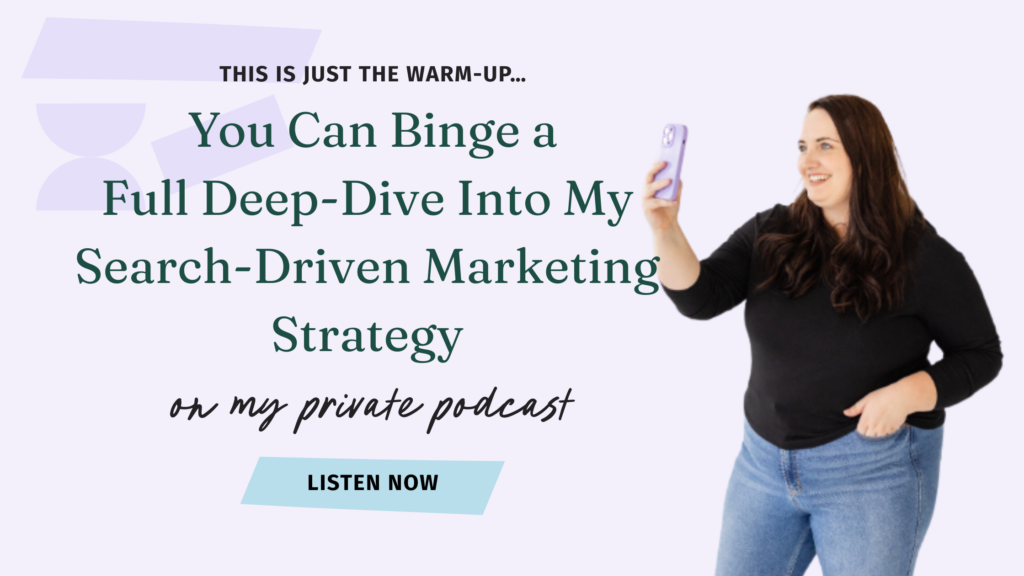Are you spending hours creating content and seeing little to no results? That’s a common frustration—and if you’re like most small business owners, you’re juggling Instagram, blog posts, emails, maybe even Pinterest or YouTube, and wondering why nothing seems to be working. Don’t worry, I’m going to share five of my best content marketing tips with you today!
I’m Kara, a content marketing strategist specializing in done-for-you blogging and Pinterest for small business owners and creative entrepreneurs. I’m really excited to talk about this, because content marketing is one of the most effective ways to grow your business—but it often comes down to small, strategic tweaks.
So let’s dive in.
Table of Contents
Tip #1: Know Your Audience
Stay with me—I know this sounds like a cliché, but let’s go deeper.
Many business owners feel like their content isn’t working because they’re not seeing big numbers—huge impressions, tons of website visits. But the truth is: you don’t need a million impressions. You need the right audience.
If you’re reaching the right people, you actually need far fewer of them to see real results.
This is especially true when it comes to keyword research for SEO. Too often, we overlook specific, lower-volume keywords because they don’t look impressive. But those niche keywords? They’re often more than enough—because they speak directly to the people who are actually looking for what you offer.
When I say “know your audience,” I don’t mean memorizing their coffee order. I mean understanding the real problems they’re trying to solve—and how your product or service fits into that.
Sometimes what they’re searching for isn’t exactly what you sell, even though it’s what they need. That’s your opportunity to bridge the gap: speak to what they think they want while educating them on what they truly need.
Use their language—mirror the words and phrases they use. I know you’ve heard this before, but it’s worth repeating.
Especially in the online space, we often describe ourselves with niche titles—storytelling strategist, client experience strategist, systems specialist. Those might be accurate, but people aren’t always searching for those terms. They’re searching for things like “how to set up my CRM” or “why do clients keep ghosting me?”
People are searching for things like: “What do I do?” or “Why isn’t my marketing working the way it should?” And that’s where positioning comes in. You need to frame your offer as the solution: You need a better XYZ strategy. You need a client experience specialist. Whatever your offer is, help them connect the dots between their problem and your solution—even if they don’t realize what the problem truly is yet.
Even if you believe your client experience is a 10 out of 10, no notes—your audience may still need help recognizing how to fix what’s not working. And that’s where your content comes in.
Tip #2: Create Valuable, Actionable Content
This might sound obvious, but hear me out.
In my opinion, most service providers worry way too much about giving away too much in their free content. But the truth is: your ideal client isn’t going to DIY the entire thing—they’re going to hire you.
I could walk you through exactly how I blog for clients or manage their Pinterest accounts, step-by-step. And the people who are ready to work with me would still reach out—because they don’t want to do it themselves. They want it done for them.
The same goes for web designers, brand photographers, or anyone offering services. Giving value doesn’t make you less hireable—it makes you more trustworthy.
When applying this to your content strategy, aim to solve one specific problem per piece of content. Keep it focused. Address different angles of the same problem if needed, because most people’s pain points fall into a few key buckets: they’re overwhelmed, they don’t have enough time, they want to make more money, or they’re frustrated with not meeting their goals.
Your job is to speak directly to those pain points—and to do it using their language, not yours.
And here’s the part a lot of people miss: your audience isn’t just looking for information. Yes, they may land on your blog post through a Google search, but what they’re really looking for is a quick win—something they can implement right away.
That’s how you differentiate yourself from AI content. AI can give facts. You can give direction. You provide a pathway—and that human element is something AI still can’t replicate (at least not well).
Your content should empower them to take the next step, even if that step is small.

Tip #3: Be Consistent Without Burning Out
This is the hardest part of content marketing for small business owners—especially when you’re using long-term, search-driven platforms.
As someone who specializes in this kind of marketing, I get it. I tell my clients it usually takes 6 to 12 months to start seeing results. And yes, that can feel discouraging when you’re investing time and money and not seeing immediate sales.
But here’s the reality: before you get to page one of Google, you’ve got to land on page five… and before that, page seven… and maybe even page twenty. It’s a process. You don’t usually start making money until your content ranks high—and ranking high takes time.
So how do you stay consistent without burning out?
- Pick a frequency you can actually stick to.
Weekly or biweekly is ideal. Once you go monthly (or less), you stretch out your timeline even further. Remember, at even a biweekly pace, it can take 6–12 months to see progress. Posting just once a month? You could easily be looking at 12–18 months before content starts to generate real traction. - Batch your content.
Record two podcast episodes at once. Write three blog outlines in one sitting. Whatever your content format, try to create multiple pieces at a time. It’s more efficient and helps maintain consistency. - Use a content calendar.
I know it sounds basic, but having a calendar is so underrated. It helps you see what you’re publishing, stay organized, and—most importantly—reminds you to repurpose (which leads us to tip #4). I use Enji as my content calendar!
I actually have another video that goes deeper into my summer marketing plan and repurposing strategy here if you want to watch!
Tip #4: Repurpose Your Content
The longer you’re in business, the more you realize this: you don’t need more content—you just need more mileage out of the content you already have.
Here’s how to repurpose strategically:
- Turn one blog post into:
- A carousel for Instagram
- A 60-second Reel
- A short email newsletter
- A YouTube script
- …and more
The possibilities are endless.
My challenge for you: Ask ChatGPT (or “Chatty Beauty,” as I call it) to help you brainstorm new ways to reuse your content. You’ve already invested time into planning, creating, maybe even getting camera-ready—so make that content work harder for you.
Honestly, the goal should be: one idea = five outputs. That’s one of my best content marketing strategies.
And yes, I know some of this may sound familiar. You’ve probably heard it before. But chances are, it’s not a knowledge problem—it’s an execution problem. So I hope this video helps you take action.

Tip #5: Track What’s Working—and Ditch What’s Not
You could throw spaghetti at the wall and hope something sticks. And honestly? If you throw enough of it, something will eventually work.
But that’s not a smart strategy.
Instead, look at what’s performing. For example, if a client is blogging about four different topics but only one is gaining traction—we double down on that one. I’m not going to keep posting the other three just to “even things out.” That’s wasted energy.
When something’s working, I go all in on it—until I feel like I’ve maximized its potential. Then, maybe I’ll start weaving in other content types or topics. But most of the time, I double down on what’s already performing.
When it comes to tracking success, my go-to tool is Google Search Console. It’s free, and it’s incredibly valuable for monitoring your SEO performance—especially if you don’t use paid SEO tools.
Here’s what I focus on:
- Impressions: How many times your content appears in Google search results
- Clicks: How many people actually click through to your site
- Keywords: What people are searching for when they find your content
- Click-through rate (CTR): Which keywords are driving the most engagement
These metrics help me determine what’s resonating with my audience from a data standpoint.
But I also take a qualitative approach:
I ask clients things like:
- “Did you listen to my podcast before hiring me?”
- “Was there a specific piece of content that stood out?”
- “Where did you first find me?”
These answers aren’t always crystal clear—especially with today’s longer buyer journeys. Realistically, someone might:
- Read a blog post
- Listen to a podcast
- Follow me on Instagram
- Sign up for my email list
- And then finally inquire about working with me
By the time they reach out, they might say, “I think I found you on Instagram?”—even if that wasn’t the true first touchpoint.
So yes, it’s messy. It’s not a perfect system. But both the data and the conversations matter. Together, they give you a fuller picture of what’s working.
Final Thoughts and Recap
Let’s recap the five content marketing tips every small business owner should be using:
- Know your audience.
Speak to real problems, in their words—not industry jargon. - Create valuable, actionable content.
Don’t just inform—empower. And make it clear that you are the solution. - Show up consistently.
Pick a pace you can sustain, and stick to it. - Repurpose everything.
One piece of content should easily become five. - Track results and make strategic changes.
Focus on what’s working, let go of what’s not, and evaluate quarterly—not weekly.
And of course, because I always think of one more thing:
Review your strategy quarterly. That’s often enough. You don’t need to constantly pivot.
If this was helpful, please hit like and subscribe—I drop new marketing content every week. Thanks so much for tuning in!